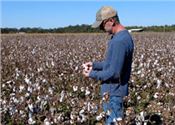Protecting Plants From Diseases

LSU AgCenter plant pathologist Trey Price.
Photo by Craig Gautreaux/LSU AgCenter
BATON ROUGE, LA.
High humidity and lots of rainfall can spell trouble for farmers. Those conditions, which are common during the growing season for row crops in Louisiana, provide an environment where plant diseases can flourish.
To make things even more challenging, it is not always clear which disease is present on a plant – making it difficult to decide on a course of action.
“Unlike weed science and entomology, we can’t physically see with our own eyes what our pest is,” said LSU AgCenter plant pathologist Trey Price, who is based at the Macon Ridge Research Station in Winnsboro. He is serving as the AgCenter’s interim corn, cotton and grain sorghum specialist.
“It’s a little more complicated figuring out what’s going on. You have to utilize a lot of different techniques to actually figure out plant diseases,” Price said.
Seeing disease symptoms such as lesions or rot is just one step of the process of correctly identifying the source of the problem. Because some diseases produce similar symptoms, field observations must be followed up with investigation in the laboratory.
Environmental conditions and diseases vary from year to year. Price embraces these challenges in his research to identify ways farmers can effectively control disease problems while keeping costs as low as possible.
“Every year is different. Every year has its own set of challenges,” he said. “I think that’s the reason I enjoy working in agriculture. There’s nothing boring about any of this because everything changes constantly.”
He often finds inspiration during his visits to farms.
“It’s really good fuel for imagination and research ideas if you go on farms and you see what’s happening in the real world and you see what’s happening outside,” Price said. “I really like to focus on things that we can apply to growers and their program that keeps them in business, that’ll solve their problems.”
“If I can save a grower a dollar by coming up with a solution, our program has paid for itself,” he added. “If we could save a dollar an acre across the state of an input cost, just think – just add all that up.” ∆